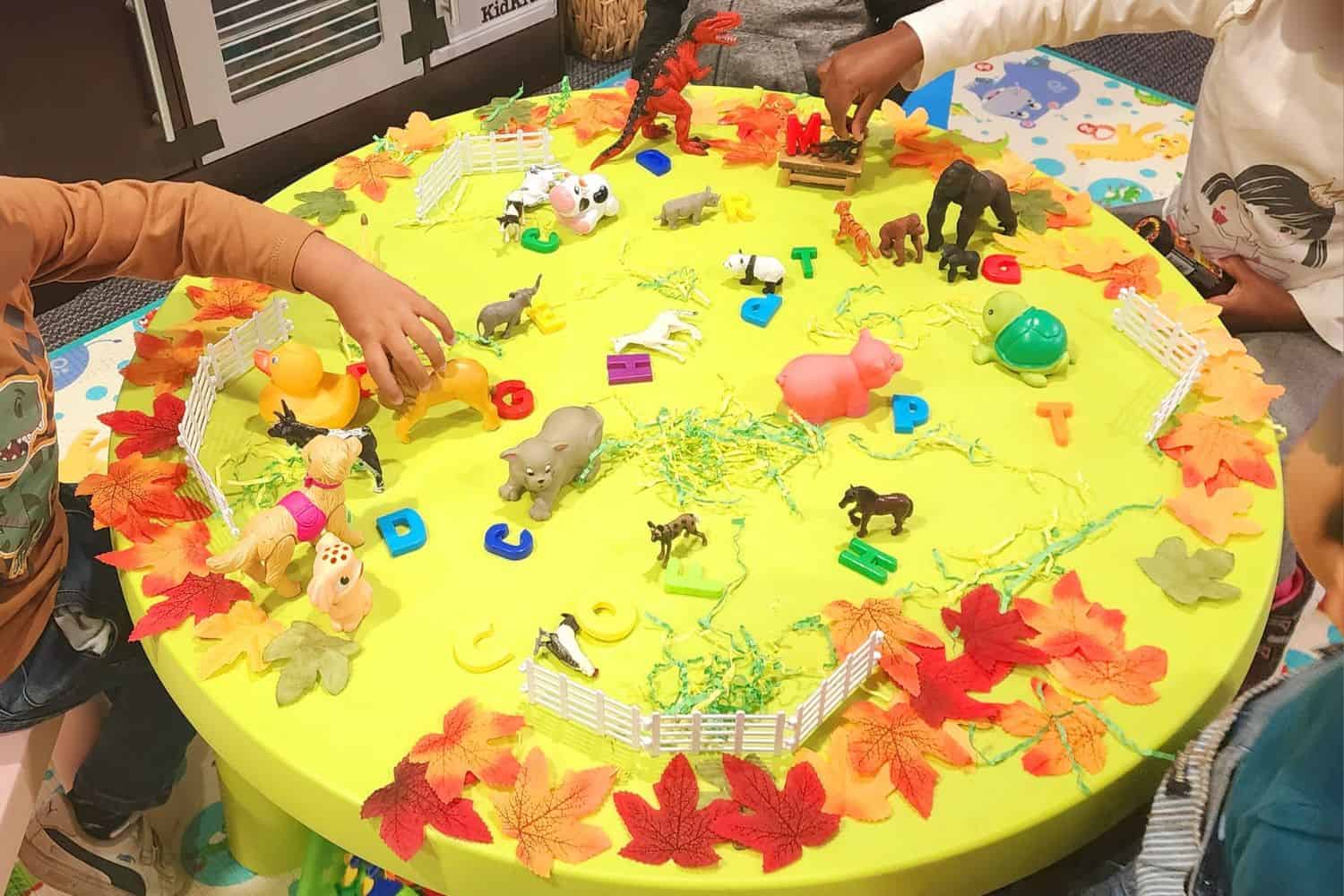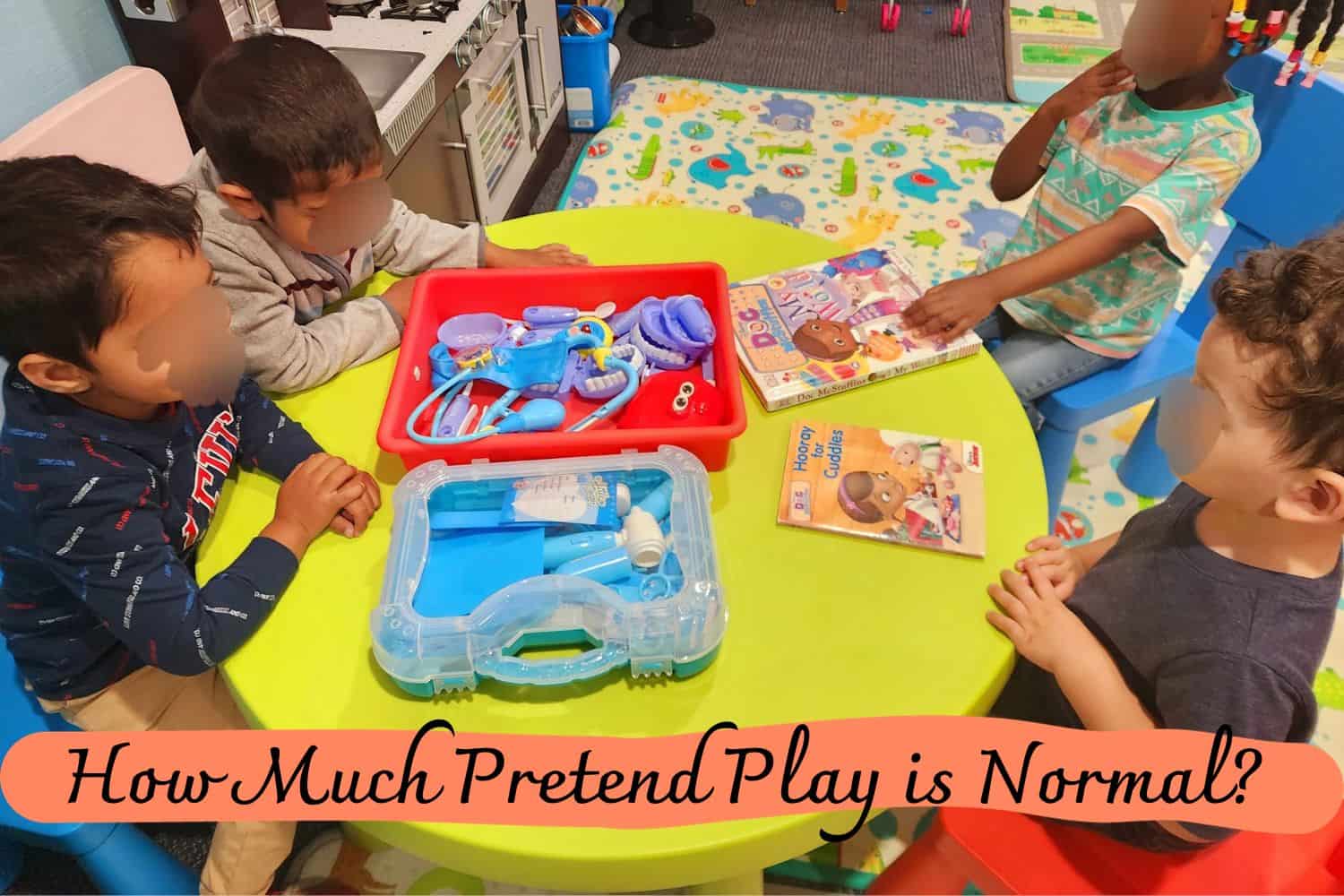Learn about the benefits of pretend play and get advice from experts on how much pretend play is normal for your child’s age and development.
How Much Pretend Play is Normal?
Do you ever catch your child pretending to be a superhero, or maybe they’re playing with dolls and creating fantastical worlds? Pretend play is an important part of childhood development, but how much pretend play is normal in children ages 2-11?
It can sometimes be difficult for parents to decide whether or not their child’s pretend games are building upon their imagination, creativity, and problem-solving skills or if it’s just taking up too much time.
While most kids outgrow it by 10 or 12, some continue to embark on magical adventures.
Fortunately, we have some helpful insight into how much “normal” pretend play looks like within this age group.
Keep reading to learn more about the importance of pretend play and what it looks like in developmentally appropriate settings!
What Is Pretend Play?

Pretend play is a captivating activity where children harness the power of their imagination to create fictional scenarios, slip into different roles, and engage in pretend interactions. It’s an enchanting journey that allows them to explore imaginary worlds, breathe life into their creative ideas, and ultimately develop their theory of mind.
But what exactly is the theory of mind? Put simply, it’s the ability to understand that other people have thoughts, feelings, and beliefs that might differ from our own. It’s a skill that blossoms over time and pretend play is the catalyst that sparks its growth.
By stepping into the shoes of someone else during pretend play, children must dive deep into their imagination and contemplate how that person would think, feel, and believe. This delightful exercise ignites empathy and helps children grasp the notion that others have unique perspectives and experiences, fostering essential learning through the wonders of Montessori pretend play.
Around the age of 5, children begin to exhibit signs of dramatic playing. It’s a pivotal milestone where they realize that others can perceive things they cannot and hold different beliefs about the world. It’s a pivotal moment in their development, fueled by the liberating and wondrous world of pretend play.
Make-believe, dramatic play, fantasy play, imaginative play, symbolic play – these are just a few of the various terms that encompass the awe-inspiring realm of pretend play. Whether enjoyed alone or with friends, in its simplest or most elaborate forms, the crucial element is always there: the sheer joy and boundlessness of allowing children to unleash their imaginations.
Power of Pretend Play for Children of All Ages

Regardless of age, pretend play is an essential building block in a child’s development. From the early toddler years to older children, engaging in imaginative and pretend play brings numerous benefits for their growth and learning.
During this crucial stage, young toddlers begin to develop cognitive, social, and emotional skills as they explore their surroundings and experiment with different roles. As children progress, Montessori pretends play continues to enhance problem-solving abilities, communication skills, and creativity.
But the benefits don’t stop there. Pretend play also fosters empathy, cooperation, and an understanding of social roles. Whether it’s playing house, creating imaginary scenarios, or immersing themselves in dramatic play, this is a pivotal time for nurturing your child’s overall development and providing them with endless opportunities for learning and growth.
How Much Pretend Play is Normal? Milestones in Pretend Play
Step into the enchanting world of pretend play, where children’s dreams come alive and their imaginations soar. Discover the exciting milestones that mark the stages of a child’s imaginative development.
Starting Pretend Play (Age 2-3):
Between the ages of 2 and 3, children embark on their journey of pretend play. They begin to grasp the concept of make-believe and use their imagination to transform into different characters or engage in fantastical scenarios. It’s an exhilarating milestone as their imagination takes its first steps.
Imaginative Role-Playing (Age 4-5):
From ages 4 to 5, pretend play becomes more complex and thrilling. Children take on multiple roles, create elaborate scenarios, and weave imaginative tales. With props and costumes, they bring their pretend play adventures to life, immersing themselves in a vibrant world of make-believe.
Expanding Scenarios and Themes (Age 6-7):
As children enter the ages of 6 to 7, their pretend play reaches new levels of intricacy. They explore a wider range of scenarios and themes, from real-world occupations to fantastical realms. With a deeper understanding of storytelling elements, they unleash their creativity and craft imaginative worlds of their own.
Symbolic Thinking and Problem-Solving (Age 8-9):
Around 8 to 9 years old, pretend play takes on a whole new dimension. Children develop symbolic thinking, using objects or actions to represent something else. They engage in complex narratives, solve pretend problems, and collaborate with friends. Pretend play becomes a source of joy, creativity, and cognitive growth.
Evolving Forms of Play (Age 10+):
As children grow older, their play transitions beyond traditional pretend play. They may explore more structured games, engage in imaginative storytelling, or pursue creative activities such as writing, drawing, or acting. While the forms of play may change, the skills and experiences gained through pretend play continue to shape their growth and development.
Each pretend play milestone opens doors to endless possibilities, fostering creativity, problem-solving, and social interaction. From the early beginnings to complex role-playing, expanding scenarios, symbolic thinking, and beyond, each milestone offers new opportunities for imaginative exploration. So, let your imagination soar and embrace the wonders of pretend play.
Conclusion
Pretend play is an essential part of a child’s development, and it’s important to make sure you provide them with the necessary props and guidance to participate in it in a creative, risk-free way.
From stimulating their imagination to facilitating a better understanding of social cues, pretend play has numerous mental health benefits.
Remember, there is no single right or wrong amount of pretend play when it comes to children; as long as they are safe and having fun, then all that matters is that they are being encouraged to explore.
So if you ever have questions about your child’s pretend play behavior or interests, be sure to ask your pediatrician for professional advice.
Also, consider talking with other parents who might have children of similar age to get some further ideas on how much pretend play is considered normal.
After all, the more you learn about learning through pretending, the better understanding you will have of what’s right or healthy for your child – while still having fun!
Thanks for reading our article How Much Pretend Play is Normal? If you want to know more information, visit our website here.
Read more:
How Does Pretend Play Help a Child’s Development?

